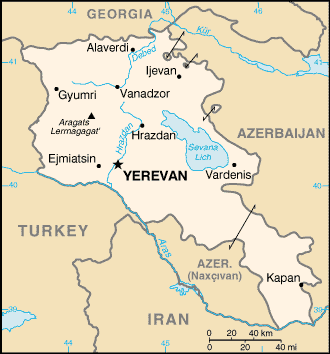Map:

Overview:
Armenia prides itself on being the first nation to formally adopt Christianity (early 4th century). Despite periods of autonomy, over the centuries Armenia came under the sway of various empires including the Roman, Byzantine, Arab, Persian, and Ottoman. It was incorporated into Russia in 1828 and the USSR in 1920. Armenian leaders remain preoccupied by the long conflict with Muslim Azerbaijan over Nagorno-Karabakh, a primarily Armenian-populated region, assigned to Soviet Azerbaijan in the 1920s by Moscow. Armenia and Azerbaijan began fighting over the area in 1988; the struggle escalated after both countries attained independence from the Soviet Union in 1991. By May 1994, when a cease-fire took hold, Armenian forces held not only Nagorno-Karabakh but also a significant portion of Azerbaijan proper. The economies of both sides have been hurt by their inability to make substantial progress toward a peaceful resolution. Turkey imposed an economic blockade on Armenia and closed the common border because of the Armenian occupation of Nagorno-Karabakh and surrounding areas.
The People:
Population:
2,982,904 (July 2005 est.)
Age structure:
0-14 years: 21.6% (male 339,453/female 305,214)
15-64 years: 67.5% (male 938,734/female 1,074,240)
65 years and over: 10.9% (male 131,519/female 193,744) (2005 est.)
Religions:
Armenian Apostolic 94.7%, other Christian 4%, Yezidi (monotheist with elements of nature worship) 1.3%
Government Type:
republic
Leader(s) to pray for:
chief of state: President Robert KOCHARIAN (since 30 March 1998)
head of government: Prime Minister Andranik MARGARYAN (since 12 May 2000)
Source: The World Factbook
View All Countries